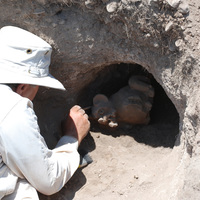
Fedor Korennoy
Related Authors
Scott Kelly
University of Cambridge
Ümit Işıkdağ
Mimar Sinan Fine Arts University
David Seamon
Kansas State University
Armando Marques-Guedes
UNL - New University of Lisbon
Ricardo Mansilla
Universidad Nacional Autónoma de México
Gary Feinman
Field Museum
Christopher Matthews
Montclair State University
Gomaa Dawod
National Water Research center
Viacheslav Kuleshov
Stockholm University
Peter Atkins
Durham University
InterestsView All (10)










Uploads
Papers by Fedor Korennoy
The modeling was based on the BAM concept, where a potential ecological niche of a species is defined as an intersection of Biotic and Abiotic factors as well as an ability of the species to Migrate within the available area. The entire area of Eurasia with a cattle density higher than 0.5 heads/km2 was chosen as a model area (M), while abiotic factors were presented by a set of bioclimatic variables describing peak and trend values of the air temperature and precipitation within the study area. The maximum entropy-based algorithm (Maxent) was applied to obtain a probability surface indicating an environmental suitability to LSD vector habitat using known LSD cases in Eurasia 2012 – 2020 as the presence locations. After calibration with the current climate data, Maxent model was projected with bioclimatic variables recalculated using the climate model INMCM4 for a ‘mild’ (RCP4.5) and ‘tough’ (RCP8.5) scenarios for 2041 – 2060.
The results suggest a high suitability of the large territories of the South-West Europe, Mediterranean region and Central Asia for the LSD transmission. An expected climate change by a “mild” scenario may cause a strongest increase of the suitability in the Central Asia affecting the large areas of Kazakhstan and Russia, as well as in South East Asia. A “tough” climate change scenario may lead to a less pronounced expansion of the disease range in the Central Asia, while large territories of East Asia (Far East of Russia, eastern parts of Mongolia and China) are expected to become more suitable for the disease vector.
Results of the study may contribute to the improvement of the current LSD preventive strategies by providing mapping background for the targeted surveillance and vaccination campaigns.
The study is a part of the Research Project 18-05-60037 by Russian Foundation for Basic Researches.
African swine fever (ASF) is a contagious viral disease of domestic and wild pigs, which since its introduction in 2007 has been spreading in the territory of the Russian Federation (RF), affecting both pigs in backyard holdings and large commercial farms, and wild boars. The disease leads to nearly 100% mortality in infected animals and causes huge economic losses to the country’s pig industry (Klinovitskaja et al., 2016). In the course of epidemics, the disease demonstrates both local transmission, which happens within relatively limited area between neighboring farms, villages, etc., and far distant transmission that leads to infection of new regions (Oganesyan et al., 2013; Malogolovkin et al., 2015). Previous studies found 156 km to be an average distance of the ASF spread between farms (Korennoy et al., 2014) and 133 km to be a maximum distance of the disease cases’ clustering in wild boars (Iglesias et al., 2016).
The objectives of the present study were: 1) to detect spatio-temporal clusters of the ASF outbreaks the RF, treated as local epidemics; 2) to analyze within-cluster dynamics of outbreaks emergence in domestic and wild pigs; and 3) to reveal associations between within-cluster disease spread patterns and some geographical factors, which supposedly facilitate the local transmission of the ASF virus.
Methods
A map of the ASF outbreaks in the RF 2007-2015 was created using the national ASF incidence records. The Kulldorff space-time scan statistics (Kulldorff et al., 2005) was employed as a cluster analysis method to detect local ASF epidemics in: 1) domestic pigs’ population (DP); 2) wild boars population (WB), and 3) cumulative population of both. The main quantitative parameters of clusters including the radius, duration and the observed number of outbreaks were obtained. The correlation between the number of outbreaks and geographical factors within each statistically significant cluster was estimated.
Results
A total of 17, 9 and 17 statistically significant ASF outbreaks’ clusters were detected in PD, WB and cumulative populations respectively. It was found, that all clusters in WB comprise at least one outbreak in DP within the same time period, while only 7 out of 17 clusters in DP comprise WB outbreaks. Majority of cumulative population’s clusters in southern regions of the RF starts from outbreaks in WB, while clusters in central and north regions mainly start from DP outbreaks. Strong positive correlation between the observed number of outbreaks in domestic pigs and the total motorway length, total pig population and the number of rural settlements within the clusters was detected (Pearson correlation coefficients r = 0.83, 0.80 and 0.89 respectively). The number of outbreaks in wild boars and the forest coverage within the clusters were also found to strongly correlate (r = 0.96).
Conclusions
Our results agree well with the findings of previous studies, which revealed associations between the local ASF spread patterns and density of domestic pigs, densities of major roads and some other human economic activity-related factors (Korennoy et al., 2014; Vergne et al., 2016). It can concluded that the wild boar population should not be seen as a primary source of the disease spread in the RF. The obtained results are expected to contribute into development of a geospatial model for assessment of risks of the ASF local spread in case of the virus introduction into new areas.
Modeling was based on the data on ASF outbreaks in domestic pigs from the largest cluster. MaxEnt software was used for suitability analysis that allows to reveal the associative relations between localization of ASF cases and risk factors, such as swine population density, human population density, settlements density, roads density. Statistical analysis and distributions fitting were performed by means of @Risk software package.
Statistical analysis of distances distribution shows the mean distance between two subsequent ASF outbreaks is 156 km (95% CI: 0 – 467). The average time interval between subsequent outbreaks is 8 days (0 – 23). These parameters allow to create an exponential probability surface around an ASF outbreak location, which reflects the risk of the next case emergence within the MaxEnt suitability surface.
The main conclusions are as follows: a) the leading factor of ASF virus spread is transportation of contaminated animal products from the focus of infection; b) the established size of risk zone of 20 km around the focus of infection is insufficient for effective control of the disease.
More than 280 ASF outbreaks have been reported from private holdings, large pig-breeding farms and in wild boars population in the territory of the Russian Federation since 2007. The analysis of spatial distribution of ASF cases performed by means of GIS-technologies demonstrates a correlation between the disease spread and direction of primary transportation links, domestic swine population density and human population density. This allows us to make a conclusion about predominately anthropogenic nature of the virus transmission by transportation and trade of live animals and contaminated agricultural products. MaxEnt software modeling with regard to detected risk factors allowed us to create a risk map which indicates the probability of emergence and spread of the disease in different regions of the European part of the country.
The evaluation of economic losses caused by ASF in 2010-2011 was performed using the methodology adopted by the OIE considering both direct impact to livestock sector (costs of animal slaughter in the focus of infection and depopulation in the risk zone, losses of processing industry, indemnity payments to owners) and indirect losses associated with transportation and touristic restrictions, feed and grain trading bans etc. According to experts’ opinion the total economic damage was 2271 million Rubles (about 57 million Euros) in 2010.
This research is devoted to the estimation of basic reproductive ratio (R0) of African swine fever (ASF) in domestic pigs at within- as well as between-holdings level. Recently published detailed data on pigs’ mortality during the ASF outbreak in Odessa region of the Ukraine in 1977 were used for estimation of R0. The epidemic has affected 20 settlements, in which domestic pigs were infected both at large farms and at private backyards. Timely application of control measures allowed successful eradication of the epidemic and prevention of further spread of the virus.
Methods
The method of early exponential-growth rate based on the analysis of an epidemic curve was chosen for estimation of R0. The course of epidemic within farm at Usatovo village demonstrates three epidemic waves that could be caused by consecutive infection of pigs from one pigpen to another. An exponential curve was fitted to the initial phase of each wave followed by calculation of R0 by simulation of infection period’s duration using Monte-Carlo method. Similarly, an exponential curve was fitted to the incidence data at between-farm level. The period of time from the date of symptoms onset at the farm to the date of confirmation of diagnosis and applying quarantine measures was taken as an infectious period.
Results
The modeling estimates a basic reproductive ratio within an infected farm as 5.9 (2.3 – 12.8), and at between-farm level as 2.0 (1.1 – 4.9). The values are consistent with the results obtained by other authors.
Discussion
Detailed data on natural dynamics of mortality, particularly within affected farm, are rarely available and, thus, are especially valuable. Results of the work have importance for understanding of the ASF epidemic process from practical point of view since they can help preventing the spread of the disease at different levels more effectively.
The basic instruments of geostatistical analysis that are used in the practice of epidemiological analysis are the calculation of Mean Centre allowing to estimate the tendency of disease-front advance in time; and Standard Deviational Ellipse that allows to define the main direction of the disease spread.
The simplest GIS tool that allows estimating the tendency towards the cases clustering is the Nearest Neighbor Index. Other program instruments that are also frequently used are Moran’s I Statistic and Getis-Ord Statistic, based on which it is possible to visualize the existing cases’ clusters. Multi-Distance Cluster Analysis: Ripley K Function is another useful tool for the estimation of case clustering at different distances from the mean center.
To define the correlation of disease cases with geographical and socio-economic factors in the study area, a methodology of Associative Analysis is applied. This methodology means the application of a regression model that correlates the Spatial Density of cases’ distribution within the territory with the values of the selected geospatial and socio-economic variables. Based on the obtained regression equation, a risk map can be created that illustrates the probability of emergence of the disease within the study area.
One of the novel methods that are used to detect the habitat of a certain host/causative agent/parasite species is the Maximum Entropy Modeling. MaxEnt software (Princeton University, USA) allows to carry out a complex analysis of habitat factors and to create a probability map which illustrates suitable conditions for the habitation of a particular species. We suggest using MaxEnt software for the analysis of possible emergence of disease cases in the territory of study due to an aggregate of geographical and socio-economic factors. This method was used for analyzing of African swine fever cases distribution in the territory of Russian Federation.